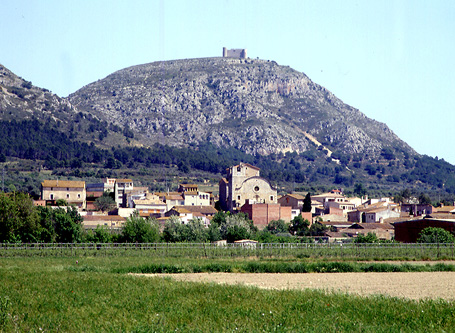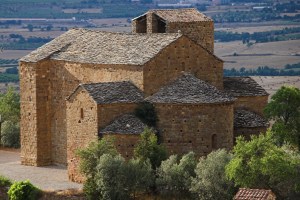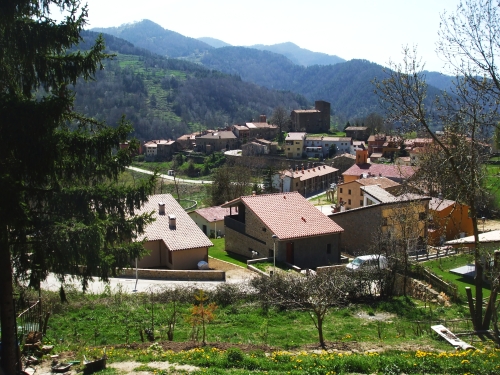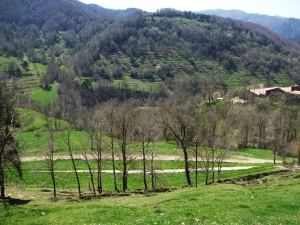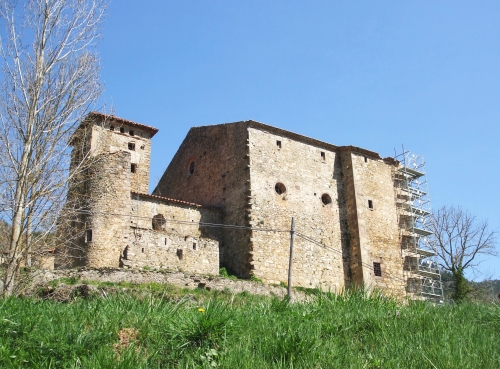Those of you still reading this blog from a long time back will remember, perhaps, that for a good while I was working on an article about a Catalan monastery called Sant Pere de Casserres (in Osona, that’s important), which seemed to get more complicated every time I looked at it; some new source or problem became apparent which was itself difficult to get or to incorporate and so on… It got me several blog posts, but the actual article I was only able to finish and send out in early 2018, and even that was a bit of a surprise. (It should be coming out later this year, for those of you who may be interested.1) But between about 2014 and 2018, the blockage was that I had discovered that there were probably relevant documents in the Archivo Ducal de Cardona, which resides in Toledo, and to which I could not easily get. The person who had told me this was editing them, however, and in late 2017 his edition actually emerged.2 So as soon as the chance arose I dived into it, and I will tell you next post about how much difference that made, but while I was gathering the information, I became briefly quite interested in a little place called Ardèvol.

Aerial view of the centre of Ardèvol, including the watch-tower that the village webpage thinks is 10th-century but which I, partly because of the work done for this post, suspect is mid-11th at the earliest. Photo by De Celsona – http://picasaweb.google.com/Celsona/ArdVol#5171644339944900722, licensed under CC BY 3.0, via Wikimedia Commons
Ardèvol appears in nine documents in the Archivo Ducal, and as far as I know it doesn’t appear in any other archive, though I haven’t gone looking; I’ve just never seen the name anywhere else. The first of the nine is from 979 CE; three more follow from 980, two from the same day; one from 982; one from 984; it’s mentioned as a boundary in one from 998; and then, nothing more till 1130, by which time it had a castle, and I’ll come back to that.3 But our basic window on this place is 979 to 984, in six documents, and all of them are sales of land to the elderly Viscountess Ermetruit of Osona. That caught my attention because that is also the pattern around Sant Pere de Casserres, which she tried to set up by much the same means, buying up everything she could get and then (probably—but see the article) bestowing it on the monastery. That probably didn’t mean anyone even moving, just changing to whom they paid their rents. But out here in Ardèvol, there was no monastery; rather, she seems to have been setting up a family stronghold at Rocafort. But apparently not in her plans, the family managed to get themselves a controlling interest in the frontier town of Cardona, which Count-Marquis Borrell II reestablished in 986 with Viscount Ermemir II as its patronus (because Borrell has to be in this story somehow). Rocafort remained a family fortress, but the lineage effectively ran out of Cardona thereafter and had, before long, even changed their family name to that of the city.4 So this is probably why we stop seeing anything of Ardèvol; it just ceased to be part of the plans of those who generated our record of it.
That said, it is surprising it was part of any plan, because it was out in the back of absolutely nowhere. To be honest, as the above shows you, this is still true, but even if you couldn’t check a map, you would know from the documents and the descriptions of the property that Ermetruit was buying. One estate is surrounded on all sides by forest, for example. That’s the most extreme, but of the six purchases four were entirely land which the sitting owners had themselves cleared from wasteland and the other two were partly so; in fact, in the case of the last they hadn’t even finished and part of the property was still wasteland as sold.5 So this was the colonisation frontier in a completely real way, and it might be suggested that it just didn’t get any further.
Now, that same Google map makes it clear that it got at least some further development, because as you will see if you zoom out by one click on that map, it’s bifocal, with two churches perched a few miles from each other. One of them, Sant Just, is high up, with maybe six other buildings round it that could, from the satellite view, all possibly now be part of the same farm complex. The other church, Santa Maria, seems to sit bang opposite a tower which must be part of the the Castell that shows up in 1130; there were apparently 114 people living in the whole settlement as of about 2011 (when the village webpage was last updated), but I suspect that we’d have seen more going on here if we could have focused on our Google Map on, say, 1830 than since the post-war move to the cities that has emptied a lot of the Catalan countryside.6 Nonetheless, this is mountainous land and probably no-one ever got rich farming it. So what would we have seen if we could have focused the Google Map on 984?
This is a question worth asking because Viscountess Ermetruit obviously thought she could do something by owning this little patch of nowhere. Its proximity to Rocafort, which is not the only castle nearby either, must be part of the answer, but the area was also not absolutely empty. Not many people had neighbours, as we’ve seen, and where they did it was often often already Viscountess Ermetruit and her sons (suggesting other purchases we don’t have). Nonetheless, almost no-one recurs in these documents; it’s almost a different set of people every time. There is also a recurrent priest who wrote four of these charters, also called Ermemir, but I suspect he wasn’t actually from the area because he seems to have been very unsure how any of the locals’ names were spelt.7 It is, in any case, quite unlikely that there was a church yet for him to minister in (and there is no mention of a castle either, which along with the quite severe and Crusaderish architecture is why I think that tower is not tenth-century, though an older cylindrical one which apparently fell down in 1932 might have given me second thoughts). But there are fourteen households named all told, though admittedly three are said all or some to be dead, suggesting that some lands had already fallen unoccupied. At that rate, the settlement was clearly already some kind of focus, just a rather scattered one. Each family was presumably breaking into their own separate plot of wilderness in the hope that this would be the happy future of things, and that some day they, or their children, would have that church and square and some of them would go out into the world, perhaps in the viscounts’ retinues, and some of them would stay and carry on making their homes as best they could. (They may not have anticipated the public swimming pool which this village of 114 people now boasts, but to be honest who would have done?)

I admit, the masonry admits of other views as well. Photograph by PMRMaeyaert – Treball propi, licensed under CC BY-SA 3.0 es, via Wikimedia Commons.
Now, a sequence of documents that ends abruptly just before the year 985 has ominous implications in this area, because that was of course the year of the attack by the Muslim first minister al-Mansur, what local documents called ‘the day Barcelona died’; but I don’t think that’s the answer here, because it’s a long way north of any route anyone normally supposed that army took.8 I think, instead, that the resultant refortification of Cardona, twenty or so miles to the east still, refocused the viscounts’ endeavours. Probably Alfons, Godmar and Ermemir and their six other neighbours were still there doing their stuff; but since the viscounts didn’t buy any more land there, we don’t know anything further. Later on the castellans of Rocafort seem to have claimed to hold a castle next door to Ardèvol, Matamargó (which still has a pretty little museum), but evidently Ardèvol did also get its own castle, because look, there it is, so maybe the fact that that document is forged should matter for this deduction.9 Eventually, anyway, there were clearly enough people around to justify not just one but two churches, but it was possibly never really part of anything bigger because first the frontier came dangerously close, close enough to magnetise investment away from here, and then it went away in the way that Paul Freedman long ago described for Vic, and the rest is for someone else to tell.10 But although this is in no way what I was looking for – for that see next post – the fact that in sorting through charter evidence you get these tiny stories of people trying to make a life is one of the things that keeps me hooked on doing this kind of work.
1. And that will be, I believe, as Jonathan Jarrett, “On Stone and Skin: Inscription of Communities at the Foundation of Sant Pere de Casserres” in Studia Monastica Vol. 63 (Barcelona forthcoming).
2. Francesc Rodríguez Bernal (ed.), Col·lecció diplomàtica de l’Archivo Ducal de Cardona (965‒1230), Diplomataris 71 (Barcelona 2016), online here.
3. Rodríguez, Archivo Ducal, nos 7, 8, 9, 10, 16, 19, 24, 360 & 378. Note that Rodríguez’s index (ibid. p. 772 s. v. ARDEVOL) omits no. 7, and that his date for no. 19 is wrong.
4. This is a story which Dr Rodríguez has now made his own, and you can access it via his works such as Francesc Rodríguez Bernal, “Els vescomtes d’Osona: Dades familiars i gènesi patrimonial d’un llinatge nobiliari pels volts de l’any 1000” in Imma Ollich i Castanyer (ed.), Actes del Congrés Internacional Gerbert d’Orlhac i el Seu Temps: Catalunya i Europa a la fi del 1r. mil·leni, Vic-Ripoll, 10-13 de novembre de 1999 (Vic 1999), pp. 163–173, and indeed the introduction to Rodríguez, Archivo Ducal, pp. 7-58.
5. Forest on all sides ibid. doc. no. 7; nos 7, 8, 9 & 19 all clearances by the current occupant; 10 & 16 partly so; 16 still partly waste.
6. I should admit that I know about that mainly from Imma Ollich i Castanyer, Maria Ocaña i Subirana, Maties Ramisa i Verdaguer & Montserrat de Rocafiguera i Espona, A banda i banda del Ter: Història de Roda, L’Entorn 30 (Vic 1995), pp. 177-254, and since Roda was or became a textile town of about a hundred times Ardèvol’s size, I would have to guess that their history may not be very similar.
7. The only definite recurrence is one Alfons, in Rodríguez, Archivo Ducal, doc. nos 9 (as neighbour) and 16 (as seller); Godmar, one of the sellers in ibid. doc. no. 7, may also appear with land in Cardona ibid. 11, 13 & 14, but 14 makes it clear that there were at least two Godmars in the viscounts’ circles at this time; Ermemir, a seller ibid. doc. no. 8 may also recur in 11, 13 & 16. The priest Ermemir wrote ibid. doc. nos 8, 9, 10 & 11. Other named persons are Lanfred, Miró and Vivenda, part of the same team as Godmar in doc. no. 7; Ermemir’s wife Sesnanda, Miró and his wife Imol in no. 8; Fruilà, Franco and Arnulf as neighbours in no. 9; Altemir & Eiló in no. 10; Alfons’s wife Saruilda and a widow called Aió selling in no. 16, along with Usila, Fidela widow of Fadribert and the late Undila and his late children as neighbours there; and Guiscafred, Ansall, Alaric and Gostremir selling in no. 19, with Bermon and his wife Eiló and a dead guy called Domènec as their neighbours.
8. See on all this Gaspar Feliu i Montfort, La presa de Barcelona per Almansor: història i mitificació: Discurs de recepció de Gaspar Feliu i Montfort com a membre numerari de la Secció Històrico-Arqueològica, llegit el dia 12 de desembre de 2007 (Barcelona 2007).
9. The forged castle claim is Rodríguez, Archivo Ducal, doc. no. 24.
10. Referring to Paul Freedman, The Diocese of Vic: tradition and regeneration in medieval Catalonia (New Brunswick 1983), online here.


